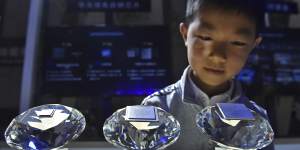On Tuesday last week,the US Commerce Department said it would significantly restrict exports of the chips used for artificial intelligence,closing what had been seen as loopholes in earlier export bans. The high-end chips are seen as critical to next-generation artificial intelligence applications,including for military uses.
The ink had hardly dried on that news when,on Friday,China announced it was imposing export controls on graphite,a key component of the anodes in electric vehicle (EV) batteries. China is the world’s leading producer of graphite,supplying about two-thirds of the world’s demand last year and refining about 90 per cent of the graphite used in EV batteries.

A Chinese EV factory:graphite is a key component in electric-vehicle batteries.Bloomberg
The measures are enhanced controls rather than outright bans – more of a warning shot than an export embargo – but will inevitably have an impact on the supply and price of both natural and synthetic graphite.
China produces about 90 per cent of the world’s synthetic graphite,a material developed from hydrocarbons that has become increasingly popular with EV battery manufacturers because it produces better and more consistent performance than natural graphite. It lasts longer,charges faster and is safer.
The US move to impose new restrictions on advanced chips will hit Nvidia hardest,given it is the leading producer of the chips for AI applications and had developed new versions of its chips for China that didn’t trigger the performance thresholds in the previous export restrictions.
The tighter export curbs appear to have been a response to last month’s launch of Huawei’s new smartphone,boasting its first higher-end processor since the US imposed sanctions on the company in 2019.
The phone sent alarm bells ringing because its capabilities represented a big advance in China’s advanced semiconductor capabilities. It demonstrated an ability to design and manufacture a relatively advanced chip that the US didn’t realise China had.
With US restrictions extending to foundries in other countries like Taiwan and South Korea,because of the critical role American companies play within the ecosystem for advanced semiconductors,the tighter rules represent a real threat to China’s ability to compete with the US and its allies on the development of AI.
China has been stockpiling AI chips but,over time,the impact of the US crackdown will exhaust them,limiting China’s ability to improve its AI models and creating a widening gap between its capabilities and those of the US in what is regarded as a critical and transformative 21st-century technology.
With the US weaponising its dominance of the semiconductor supply chain,it isn’t surprising China has opted to deploy the most potent weapon it has in its trade armoury.
Earlier this year,after the Netherlands (with considerable urging from the US) introduced a licensing regime that effectively stopped exports of the machines that produce the most advanced semiconductors,which only the Netherlands manufactures,China announced its own export restrictions on two key minerals used in chip-making.
Exports of gallium and germanium,whose production China dominates,have consequently fallen and prices have risen and there has been a scramble by the US and its allies to find or develop alternate sources of supply. (Gallium is used in the advanced chips in new-generation mobile phones and EVs,while germanium is used to upgrade the performance of silicon and is used in fibre optics and solar cells,among other applications.)

Some believe Beijing will force Chinese chipmakers — which also continue to rely on US software and equipment — to supply Huawei.AP
The export restriction on graphite will similarly force the US and its allies to seek other sources of supply. It’s not that there aren’t other sources – the ASX-listed Syrah Resources,with a mine in Mozambique,is the biggest integrated producer outside China – but that there will be time and higher costs involved in replacing Chinese supply.
By themselves,those factors could make non-Chinese EVs both more expensive and less competitive with China’s burgeoning EV exports.
Only time will tell whether the new export rules are merely a threat or will be deployed. China would be aware that not only does its dominance of strategic minerals generate significant export revenues and technological advantages,but withholding them would jeopardise that dominance and the strategic leverage it provides.
The US,Europe,Japan,South Korea and even Australia have been busily drawing up lists of critical minerals and plans to diversify their supply away from their reliance on China in a key element of the move to “re-shore” and “friend shore” crucial and vulnerable elements of their supply chains.
Australia,with our plentiful natural resources (including reserves of about 5 million tonnes of natural graphite and delineated resources of about 8 million tonnes,mainly in South Australia) is well-positioned to be a major beneficiary of those efforts to diversify and the enormous financial incentives for friend shoring in Joe Biden’s mislabelled Inflation Reduction Act.
China’s new export regime for graphite isn’t US-specific and only covers certain types of graphite,what it calls “dual-use items” or materials that have commercial and military applications. It has said that exports that comply with its regulations will be allowed,although it isn’t clear what the framework for compliance might look like.
China’s dominance of rare earths,and graphite in particular,provide the strongest leverage it has in the trade wars with the US and,increasingly,its allies,but there are risks in deploying them and threatening to disrupt the production of EVs around the world.
The European Union,for instance,has launched an inquiry into the extent to which Chinese EV production is subsidised by Beijing,which could lead to punitive tariffs being slapped on Chinese exports to its fastest-growing market.
About 15 per cent of sales of EVs in Europe this year have been by Chinese manufacturers. If the flow of graphite to European manufacturers were disrupted,the Europeans have an obvious mechanism for retaliation of their own.
China has been effectively denied access to the US market by Donald Trump’s 27.5 per cent tariff on auto imports from China. But Beijing hasn’t built the world’s biggest and most advanced EV manufacturing base to be shut out of the world’s other large markets.
That may be why it has announced export controls rather than a straightforward ban,hoping that the threat of a ban in future will be sufficient to deter the US and others from any further attacks on its technological capabilities.
The Business Briefing newsletter delivers major stories,exclusive coverage and expert opinion..